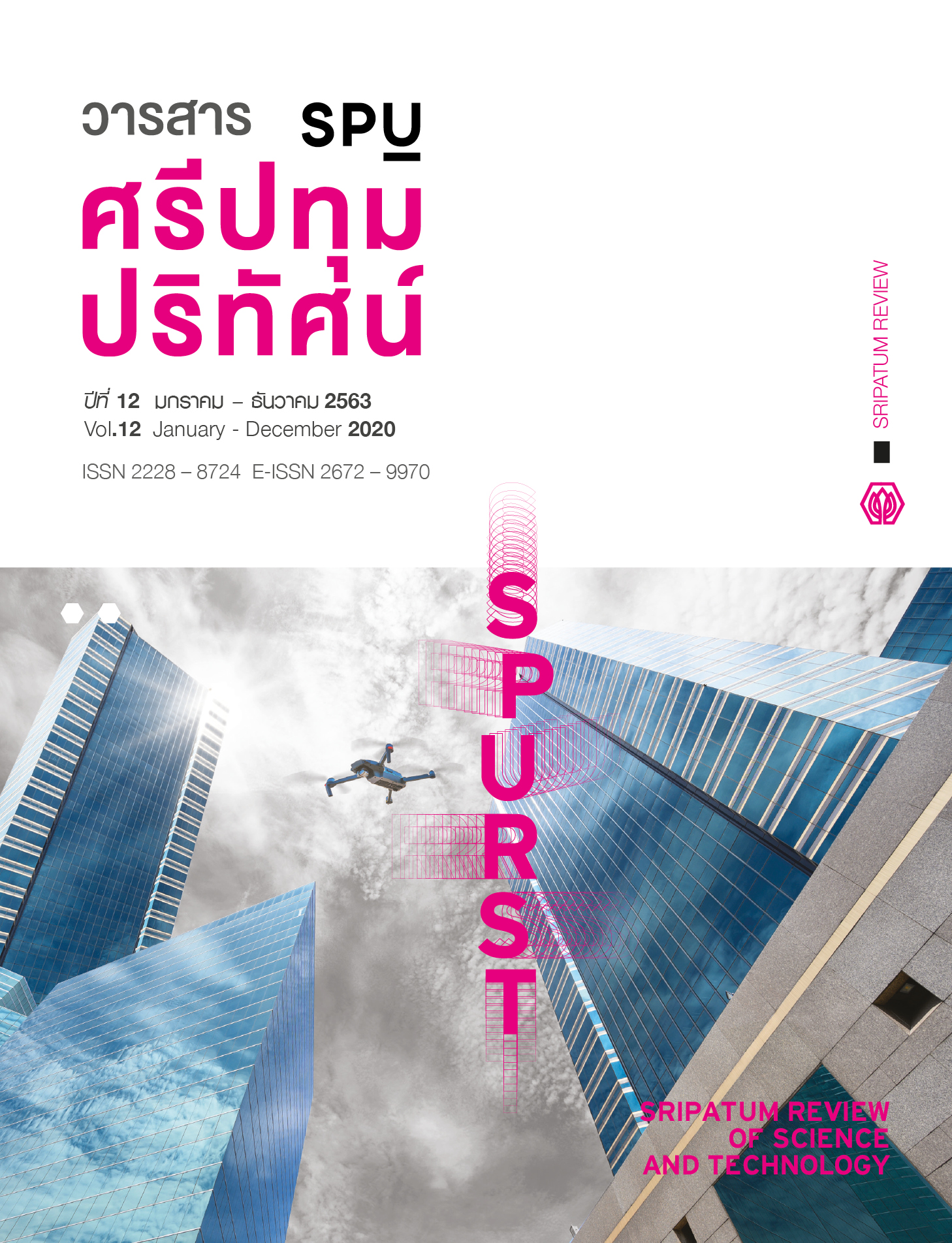การเลือกรูปแบบการกระจายสินค้าที่เหมาะสมด้วยตัวแบบกำหนดการเชิงเส้นผสมจำนวนเต็ม: กรณีศึกษาธุรกิจกระจายสินค้าเครื่องดื่ม (The Optimal Selection of Distribution Model with Mixed Integer Programming: A Case Study of Beverage Distribution Firm)
Main Article Content
บทคัดย่อ
การเลือกรูปแบบการกระจายสินค้าที่เหมาะสมสามารถช่วยลดต้นทุนขนส่งสินค้าลงได้ งานวิจัยนี้จึงมีวัตถุประสงค์เพื่อศึกษารูปแบบการกระจายสินค้าที่เหมาะสมด้วยตัวแบบกำหนดการเชิงเส้นผสมจำนวนเต็ม โดยเก็บและรวบรวมข้อมูลจากคู่ค้าทางธุรกิจของกรณีธุรกิจกระจายสินค้า จำนวน 30 ราย ในพื้นที่ภาคตะวันออกเฉียงเหนือและวิเคราะห์ข้อมูลด้วยตัวแบบกำหนดการเชิงเส้นผสมจำนวนเต็ม โดยใช้โปรแกรมสำเร็จรูป LINGO 11.0 ร่วมกับวิเคราะห์หาต้นทุนขนส่งสินค้าที่ต่ำ ได้แก่ ค่าน้ำมันเชื้อเพลิง ค่าเก็บรักษาสินค้า ค่าจ้างพนักงานขับรถบรรทุก ค่าเสื่อมราคา และค่าบำรุงรักษารถบรรทุก ผลการวิจัยพบว่า ปัญหาการกระจายสินค้าดังกล่าวเป็นลักษณะ NP-Hard เนื่องจากมีการพิจารณาหลายศูนย์กระจายสินค้า ลูกค้าหลายแห่ง และรถบรรทุกหลายขนาด ผู้วิจัยจึงเสนอรูปแบบการกระจายสินค้าที่เหมาะสมด้วยตัวแบบกำหนดการเชิงเส้นผสมจำนวนเต็ม โดยทดลองจากข้อมูลความต้องการสินค้าจริงจำนวน 5 ชุด ของธุรกิจกรณีศึกษา พบว่าตัวแบบกำหนดการเชิงเส้นผสมจำนวนเต็มที่สร้างขึ้นมีความถูกต้อง ทำให้ธุรกิจกรณีศึกษาสามารถเลือกรูปแบบการกระจายสินค้าเครื่องดื่มที่เหมาะสม ส่งผลทำให้สามารถลดต้นทุนขนส่งสินค้ามากถึง 72.85 ล้านบาทต่อปี หรือคิดเป็น ร้อยละ 58.90
Article Details
เอกสารอ้างอิง
Apiprachyasakul, K. (2014). Goods Transportation in Logistics Works. Bangkok: Focus Media and Publishing. (in Thai)
Arkararungraingkul, R., Supattananon, N., and Pimpatchim, A. (2019). The Mixed Integer Programming Model for Outbound Truck Arrangement: A Case Study of Beverage Distribution Firm. Journal of Industrial Technology, 9 (1), 41-54. (in Thai)
Bassolas, A., Gallotti, R., Lamanna, F., Lenormand, M., and Ramasco, J.J. (2020). Scaling in the recovery of urban transportation systems from massive events. Scientific Reports, 10(2746), 1-20.
Cosma, O., Pop, P.C., and Dănciulescu, D. (2020). A novel matheuristic approach for a two-stage transportation problem with fixed costs associated to the routes. Computers and Operations Research, 118(106906), 1-10.
Eiamworawutthikul, C., Manisri, C., Promwattanapakdee, T., and Jenkarn, W. (2018). Guidelines for the Calculation of Specific Energy Consumption (SEC) as Energy Performance Indicator in Transportation Operations. Sripatum Review of Science and Technology, 9(1), 118-127.
Esper Angillieri, M.Y. (2020). Debris flow susceptibility mapping using frequency ratio and seed cells, in a portion of a mountain international route, Dry Central Andes of Argentina. Catena, 189(104504), 1-9.
GSB Research. (2019). Food and beverage industry. Industry Update, 2562(1), 1-3. (in Thai)
He, Y., Qin, J., and Hong, J. (2017). Comparative analysis of quantitative efficiency evaluation methods for transportation networks. PLoS ONE, 12(4), 1-8.
Holzapfel, A., Kuhn, H., and Sternbeck, M.G. (2018). Product Allocation to Different Types of Distribution Center in Retail Logistics Networks. European Journal of Operational Research, 264(3), 948-966.
Khucharoenphaisan, R. (2009). Marketing Channels of Distribution and Logistics. Bangkok: Chulalongkorn University. (in Thai)
Orlis, C., Laganá, D., Dullaert, W., and Vigo, D. (2020). Distribution with Quality of Service Considerations: The Capacitated Routing Problem with Profits and Service Level Requirements. Omega (United Kingdom), 93(102034), 1-15.
Phongthong, P. (2018). Logistics Management for the Competitive Advantage in the Pallet Renting Business. Journal of Humanities and Social Sciences, Rajapruk University, 4(1), 91-100.(in Thai)
Solano-Charris, E.L., Prins, C., and Santos, A.C. (2014). Heuristic approaches for the robust vehicle routing problem. Lecture Notes in Computer Science, 8596, 384-395.
Supattananon, N., Supattananon, N.D., and Arkararungraingkul, R. (2019). Distribution Model Improvement with Direct Shipment Using a Mixed Integer Linear Programming. The Proceedings of the First National and International Conference of Kalasin University, Kalasin: Kalasin University, 185-197. (in Thai)
Tuzkaya, U.R., Onut, S., and Tuzkaya, G. (2014). A strategic planning methodology for the multimodal transportation systems: A case study from Turkey. Journal of Applied Mathematics, 2014(931456), 1-24.
Wisetjindawat, W., Wilson, R.E., Bullock, S., and de Villafranca, A.E.M. (2019). Modeling the Impact of Spatial Correlations of Road Failures on Travel Times during Adverse Weather Conditions. Transportation Research Record, 2673(7), 157-168.
Yap, M., Cats, O., and van Arem, B. (2020). Crowding valuation in urban tram and bus transportation based on smart card data. Transportmetrica A: Transport Science, 16(1), 23-42.
Yongpisanphob, W. (2019). Beverage industry. Krungsri Research, 2562(1), 1-13. (in Thai)
Yun, Y., Chuluunsukh, A., and Gen, M. (2020). Sustainable closed-loop supply chain design problem: A hybrid genetic algorithm approach. Mathematics, 8(84), 1-18.
Zhang, M., Hu, X., and Wang, J. (2019). A method to assess and reduce pollutant emissions of logistic transportation under adverse weather. Sustainability, 11(5961), 1-19.


